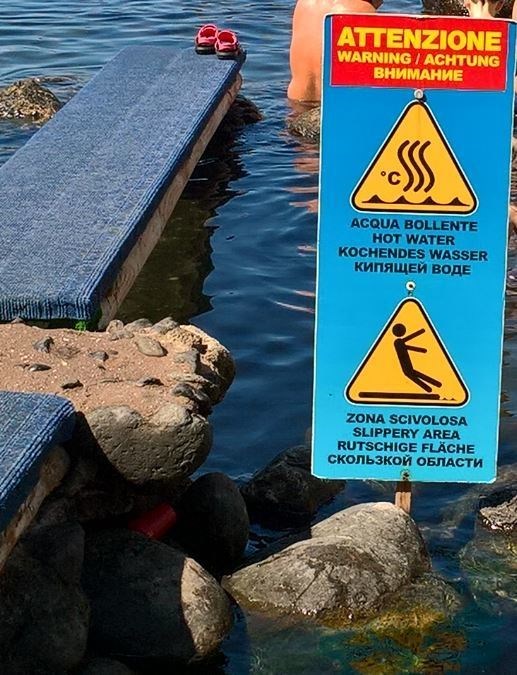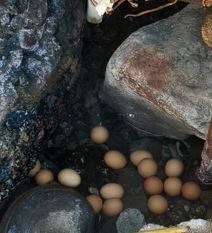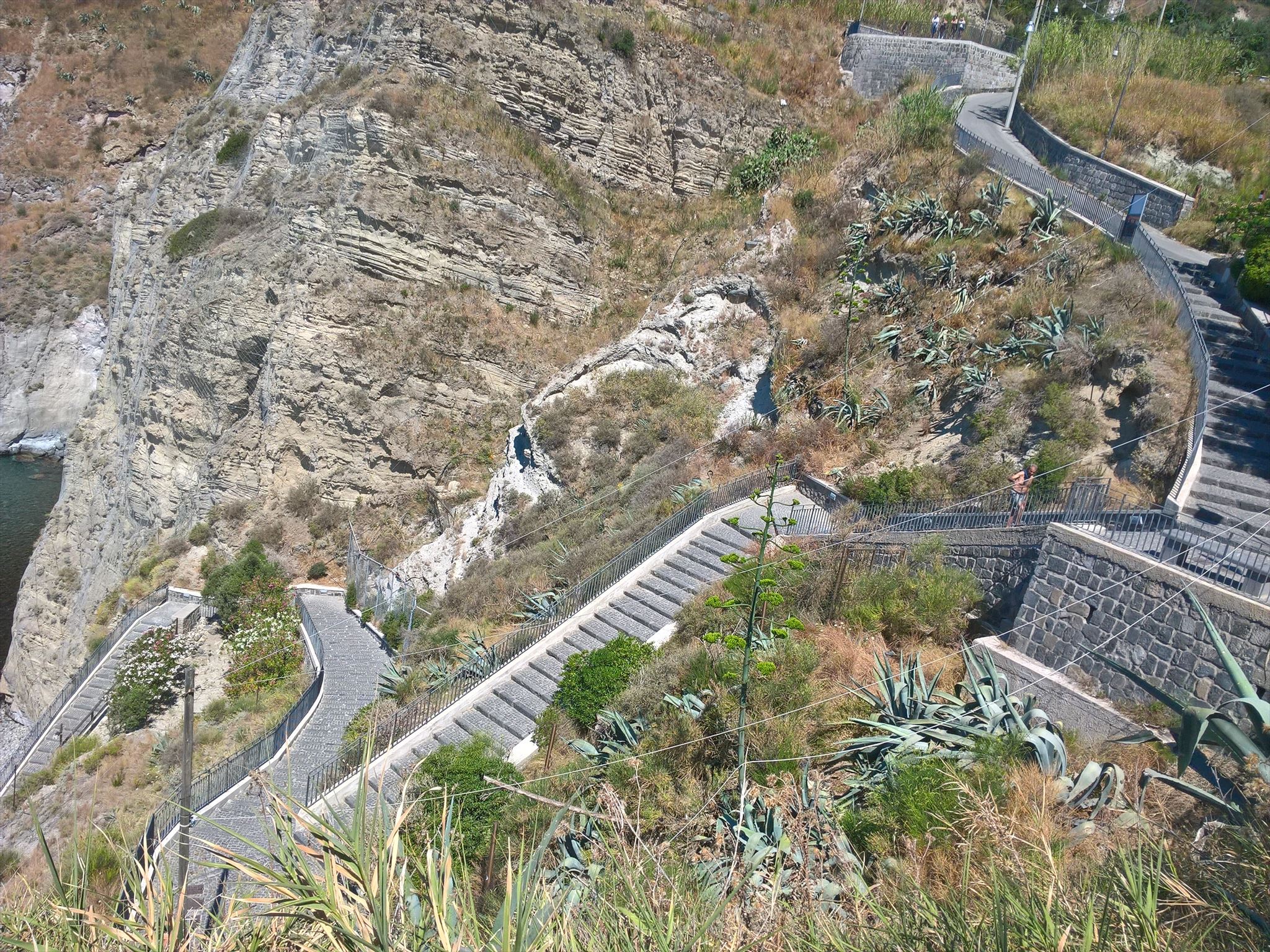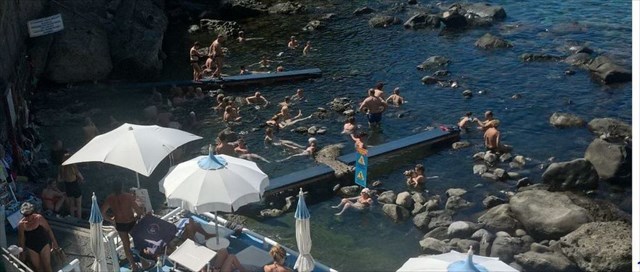 Italiano
Italiano
Ischia è famosa per le sue numerose sorgenti termali. Gli antichi romani già sfruttare le proprietà curative delle terme di Buonopane, Testaccio o dei Maronti-spiaggia.
Acqua:
Mineral sono acqua contenente più di 1.000 mg/l di componenti solidi disciolti sono da risorse idriche sotterranee e sono di purezza originaria .
termica viene dal greco e significa "tiepida o calda", in modo da avere più di 20° C in corrispondenza della posizione all'uscita avere a caldo per l'acqua calda.
Riscaldamento:
I profondi a acqua affonda nel terreno, una media di temperatura ogni 33 m aumenta di 1° C, la più calda viene riscaldata e caldo ottiene, quando ritorna in superficie, se ci si trova sulla superficie di un rilievo forte pressione.
Una ulteriore possibilità è, come mostrato in Ischia, che in circa 2,5 - un magma camera situato a 3 km di profondità. L'acqua piovana penetra e filtra attraverso il fondo poroso nella profondità. Si avvicina al camera magmatica, riscaldamento qui e si dissolve minerali.
Acqua calda si espande e così aumenta nuovamente. Mentre altri minerali e sali possono ancora essere inclusi. Così, da acqua piovana - acqua termale. Anche l'acqua di mare può penetrare attraverso le fessure della terra, sicuro per riscaldare e risorgere come l'acqua termale salata.
Se l'acqua piovana viene in un materiale impermeabile, non può cadere vicino alla camera magmatica e riscaldata da esso. Tuttavia, può essere riscaldato indirettamente. Dai gas a camera nascente magma (possono anche essere lo strato impermeabile) riscaldare l'acqua, questo dissolve minerali - il risultato è ancora acqua termale, ma contiene meno minerali ed è molto più fresco (tiepida)

Exit:
Nelle zone costiere di Ischia, l'acqua termale in sé viene alla luce, con l'aiuto della tecnologia moderna, ma quasi tutti gli alberghi in grado di mantenere la nostra acqua termale piscina. Le acque termali di Sorgeto, a sud di Panza, entfließt da un'unica fonte e l'acqua raggiunge una temperatura di 90° C la riva. L'acqua termale viene miscelato con l'acqua di mare e in questo modo formano zone con temperature differenti, a volte con acqua dolce e salata.

SORGETO è diventato noto per diversi anni a causa dei resti di un antico insediamento del 7 ° secolo, è stato scoperto sulla Punta Chiarito e, quindi, è la prova di una colonia degli antichi greci.

Romantica sulla scogliera frastagliata è la baia di Panza (accessibile dalla linea 1, CS e CD). Una strada stretta e solo 300 passi la baia di Sorgeto può essere raggiunto. Per il tempo di viaggio si deve scendere con 30 minuti di contare fino a 45 minuti.

Comodo è in barca taxi da SANT ANGELO.
Dal mare v'è una piattaforma di cemento su cui si può prendere il sole. Qui è possibile l'acqua termale fango mescolato dall'oceano in una scatola per il viso e il corpo. Si dice che la fonte SORGETO per rendere molto bello!

Condizioni di registrazione:
Imbarcarsi in Headerkoords e rispondere alle seguenti domande:
1) Descrivere la posizione di uscita dell'acqua termale.
2) direttamente ai piedi della rupe si possono cucinare le uova - quanto apprezzi la temperatura dell'acqua? Attenzione può essere molto caldo - non raggiungono in esso !!!
3) Alla fine delle due barre - quanto apprezzi latemperatura dell'acqua?
4) Perché è il diverso acqua calda?
Sarei felice (opzionale) se si desidera caricare una foto di voi o il vostro GPS ... con il registro! Invia le risposte alle domande a me (GC-account). Non è necessario attendere per un permesso di log, ti chiamo se qualcosa non va. Registri con riferimenti alle domande saranno cancellati.
 English
English
Ischia is famous for its many thermal springs. The ancient Romans already take advantage of the healing properties of the spas of Buonopane, Testaccio or the Maronti-beach.
Water:
Mineral water are water which contains more than 1.000 mg/l of dissolved solid constituents, are from underground water resources and are of original purity .
Thermal comes from the Greek and means "warm or hot", so it must have more than 20° C at the exit site to heat water.
Heating:
Ever lower the water sinks into the ground, on average the temperature increases by 1° C every 33 m, it gets warmer and warmer and ever hotter when it comes back to the surface when a strong pressure relief takes place on the surface.
Another possibility is, as shown in Ischia, that in about 2.5 - 3 km depth a magma room is located. Rainwater penetrates through the porous bottom in the depth. It approaches the magmatic chamber, heating here and dissolves minerals.
Hot water expands and so it rises again. On the way up other minerals and salts can still be included. Changes from rainwater in thermal water. Even sea water can penetrate through the crevices of the earth, sure to warm up and resurrect like salty thermal water.
If rainwater comes in a waterproof material, it can not fall near the magmatic chamber and heated by it. However, it can be indirectly heated. Gases from magmatic chamber (they can come througt the waterproof layer) heat the water, dissolves minerals - the result is still thermal water, but contains less mineral and is much cooler (lukewarm).

Exit:
In the coastal areas of Ischia, the thermal water is self-evident. With the aid of modern technology almost every hotel can have its own thermal water swimming pool. The thermal water of SORGETO, south of PANZA, flows from a single source and the water reaches the shore at a temperature of 90 ° C. The thermal water mixes with the sea water and in this way zones with different temperatures, sometimes also with sweet and salty water, are formed.

SORGETO has also been known for some years by the remains of an ancient settlement dating back to the 7th century, discovered at the PUNTA CHIARITO, which is proof of a colony of the ancient Greeks.

Romantic on the rugged cliff is the bay of Panza (accessible from line 1, CS and CD). A narrow street and round 300 steps to Sorgeto Bay can be reached. For travel time you have to go down with 30 minutes to count up to 45 minutes.

Comfortable is by taxi boat from SANT ANGELO.
At the sea is a concrete platform on which you can sunbathe. Here, the mud mixed with thermal water can be applied directly from the sea as a pack on the face and body. It is said that the SORGETO source is particularly beautiful to make!

Registration Conditions:
Go to the header coords and answer the following questions:
1) Describe the efficacy of the thermal water.
2) Right at the foot of the rock wall you can cook eggs - how high you estimate the water temperature? Caution can be very hot - do not enter !!!
3) At the end of one of the two bridges - how high do you estimate the water temperature?
4) Why is the water different warm?
I would be happy (optional) if you want to upload a photo of you or your GPS ... with the log! Send answers to questions to me (GC-account). You do not have to wait for a log permit, I'll call you if something goes wrong. Registers with references to questions will be deleted.
 Deutsch
Deutsch
Ischia ist für seine vielen Thermalquellen berühmt. Auch die alten Römer nutzen schon die heilende Wirkung in den Thermen von BUONOPANE, TESTACCIO oder am MARONTI-Strand.
Wasser:
Mineralwasser: sind Wasser die mehr als 1.000 mg/l gelöste feste Bestandteile enthalten, aus unterirdischen Wasservorkommen stammen und von ursprünglicher Reinheit sind.
Thermal kommt aus dem Griechischen und bedeutet „warm bzw. heiß“, muss also mehr als 20° C am Austrittsort haben um Thermalwasser zu heißen.
Erwärmung:
Je tiefer ein Wasser in die Erde sinkt, durchschnittlich steigt die Temperatur alle 33 m um 1° C, desto wärmer wird es aufgeheizt und umso heißer wird es, wenn es wieder an die Oberfläche kommt, wenn an der Oberfläche eine starke Druckentlastung stattfindet.
Eine weitere Möglichkeit ist, wie in Ischia, dass sich in etwa 2,5 – 3 km Tiefe eine Magmakammer befindet. Das Regenwasser dringt durch den porösen Boden in die Tiefe ein und versickert. Kommt in die Nähe der Magmakammer, heizt sich hier auf und löst Minerale.
Heißes Wasser dehnt sich aus und steigt so wieder nach oben. Dabei können noch weitere Mineralien und Salze aufgenommen werden. So wird aus Regenwasser – Thermalwasser. Auch Meerwasser kann durch Ritzen in die Erde eindringen, sicher erwärmen und als salzhaltiges Thermalwasser wieder aufsteigen.
Wenn das Regenwasser zu einer wasserundurchlässigen Schicht kommt, kann es nicht in die Nähe der Magmakammer absinken und von dieser erwärmt werden. Allerdings kann es indirekt erwärmt werden. Die aus der Magmakammer aufsteigenden Gase (sie können auch durch die wasserundurchlässige Schicht) erwärmen das Wasser, dieses löst Minerale – es entsteht wieder Thermalwasser, allerdings enthält es weniger Mineralien und ist deutlich kühler (handwarm).

Austritt:
In den küstennahen Bereichen Ischias tritt das Thermalwasser von selbst zu Tage, mit Hilfe moderner Technik kann aber fast jedes Hotel ein eigenes Thermalwasser-Schwimmbad unterhalten. Das Thermalwasser von SORGETO, südlich von PANZA, entfließt aus einer einzigen Quelle und das Wasser erreicht mit einer Temperatur von 90° C das Ufer. Das Thermalwasser vermischt sich mit dem Meerwasser und auf diese Weise bilden sich Zonen mit unterschiedlichen Temperaturen, manchmal auch mit süßem und salzigem Wasser.

SORGETO ist seit einigen Jahren auch durch die Überreste einer antiken Siedlung aus dem 7. Jahrhundert bekannt geworden, die auf der PUNTA CHIARITO entdeckt wurde und somit Beweis einer Kolonie der antiken Griechen ist.

Romantisch an der schroffen Steilküste ist die Bucht von PANZA (Erreichbar mit der Linie 1, CS und CD). Über eine schmale Straße und knapp 300 Treppenstufen ist die SORGETO-Bucht zu erreichen. Für die Wegzeit muss man runter mit 30 Minuten, rauf mit 45 Minuten rechnen.

Bequemer geht es mit dem Taxiboot von SANT ANGELO aus.
Am Meer befindet sich eine Betonplattform, auf der man sich sonnen kann. Hier kann man den mit Thermalwasser vermischten Schlamm direkt aus dem Meer als Packung auf Gesicht und Körper auftragen. Es wird gesagt, dass die SORGETO-Quelle besonders schön machen soll!

Logbedingungen:
Begib dich zu den Headerkoords und beantworte folgende Fragen:
1) Beschreibe die Austrittsörtlichkeit des Thermalwassers.
2) Direkt am Fuß der Felswand kann man Eier kochen – wie hoch schätzt du die Wassertemperatur? Achtung kann sehr heiß sein – nicht hineingreifen!!!
3) Am Ende eines der beiden Stege – wie hoch schätzt du die Wassertemperatur?
4) Warum ist das Wasser verschieden warm?
Ich würde mich freuen (optional), wenn du ein Foto von dir oder deinem GPS ... mit dem Log hochladen würdest! Sende die Antworten auf die Fragen an mich (GC-Account). Du brauchst nicht auf eine Logfreigabe zu warten, ich melde mich, wenn etwas nicht stimmt. Logs mit Hinweisen zu den gestellten Fragen werden gelöscht.
For other translation press HERE